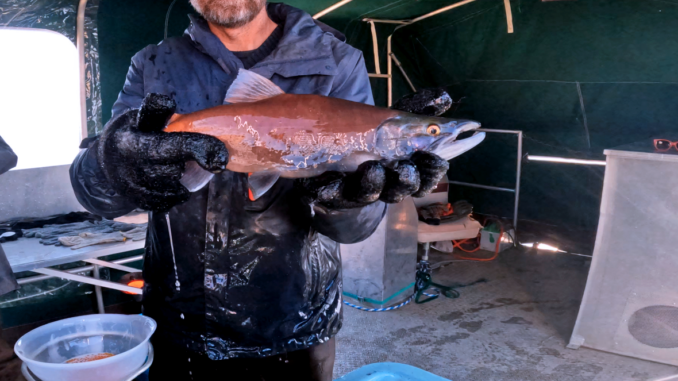
Colorado Parks and Wildlife is celebrating its third most successful year of kokanee salmon spawning at Wolford Reservoir, near Kremmling.
On October 17, Northwest Region aquatic biologists, Glenwood Springs Hatchery staff, and volunteers headed out on a floating spawn barge kicking off the kokanee salmon spawn at Wolford Reservoir. The first of many trips the team would take over the next five weeks, braving freezing temperatures for several hours to spawn kokanee salmon. Eagerly anticipating what was waiting for them in the trap set up in one of the coves with every launch.
“We weren’t sure what this year’s egg take would look like at Wolford,” said CPW aquatic biologist Jon Ewert. “By day eight we had only collected around 250,000 eggs. However, things changed overnight and by day 10 we saw a 67% increase in the number of ripe females in the trap, almost doubling the number of eggs collected.”
This upward trend in the number of ripe females would continue. On Oct. 31, the spawning team would see their biggest day yet, collecting over 302,500 eggs. Just two days later, the team would celebrate one million eggs collected at Wolford. Unfortunately, that celebration would be cut short. For the first time in eleven years, the team would shut down that day’s spawn early due to strong gusty winds creating dangerous conditions.
“This is rare — actually the first time I can recall having to shut down early due to dangerous water conditions,” said Ewart.
When the team resumed spawning the following Monday, Jon’s feeling that they still had not seen the peak was confirmed, and the hope of collecting 2 million eggs looked more like a reality. Four days later, that hope turned into reality, with the announcement the team had collected 2 million eggs less than a month into the spawning operation. This is the same number of kokanee salmon eggs collected in 2020 at Wolford.
Two days later, they would celebrate another milestone by collecting 2.5 million eggs. Something CPW aquatic biologists didn’t think would happen this year at Wolford.
“After the team completed spawning on Nov. 9, I was sure we’d start to see the spawn number decrease,” said Ewert. “When spawning was complete on the 11th, I realized I might be wrong. With a late season run of males, which does happen, we were able to hit 2.5 million eggs the following week.”
When all was said and done on Nov. 21, approximately 2.7 million eggs were collected from 4,195 ripe females.
“This effort would not be possible without our dedicated staff and volunteers,” said Ewert. “From setting up nets to spending long hours in freezing temps to spawn, plus all the other tasks that they help with, we couldn’t do this without them. They’re the reason CPW continues to have successful spawns leading to the continuation of this species in Colorado.”
Once spawned the eggs are carefully rinsed and any debris or damaged egg in the batch are removed. They are then taken back to Glenwood Springs State Fish Hatchery where they are incubated, hatched, and raised to 1-2 inches. Once fish reach a survivable size, on average about six months later, the young fish are stocked in 26 lakes around the state, including Wolford.
In addition to egg collection, the spawned kokanee are given away to ensure the meat is not wasted. This year CPW gave away 6,229 kokanee salmon collected from Wolford Reservoir to individuals and local foodbanks.
“The process in which they collect the eggs is pretty impressive,” said Northwest Region PIO Rachael Gonzales. “From how they collect kokanee in the trap for spawning to volunteers carefully sifting through thousands of eggs with a plastic spoon, the process runs smoothly. What makes it even more impressive is it’s all being done right there on the lake that’s not always calm, in bitterly cold temperatures, on a barge they’ve turned into a floating spawn barge.”
2022 marked the eleventh year CPW has run the spawn operation at Wolford and the third-best egg collection they’ve had at the reservoir. The number one year was back in 2019, with 4.6 million eggs collected. The total number of eggs taken from Wolford over those eleven years is just over 22 million, for an average of 2.0 million per year.
“That’s all from stocking just 120,000 fish annually, an excellent return rate,” said Ewert.
Kokanee spawning in the Northwest Region also occurs in the section of the Colorado River between Lake Granby and Shadow Mountain Lake, near Granby. Due to a decline in the kokanee population in Lake Granby only 13o,ooo eggs were collected this year.
Statewide, CPW collected an estimated 8.5 million kokanee salmon eggs from five locations this season. Wolford Reservoir led the state with the most eggs collected from a single body of water with 2.7 million eggs. Lake Nighthorse in the Southwest came in second with 2.3 million eggs collected.
Kokanee is the landlocked version of the sockeye salmon. Kokanee salmon were first introduced into Colorado waters in 1951 and are currently stocked in 26 lakes and reservoirs, including Wolford. Similar to the sockeye salmon, mature fish will swim upstream where they will naturally die after spawning. To learn more about kokanee salmon visit our website.
Support Northern Colorado Journalism
Show your support for North Forty News by helping us produce more content. It's a kind and simple gesture that will help us continue to bring more content to you.
BONUS - Donors get a link in their receipt to sign up for our once-per-week instant text messaging alert. Get your e-copy of North Forty News the moment it is released!
Click to Donate